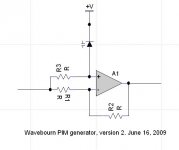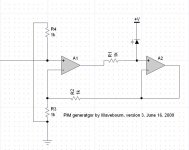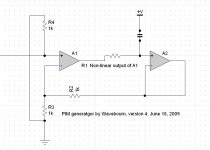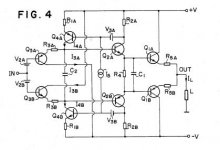scott wurcer said:
Bob didn't you mean "high open loop gain" in the first example? That was my example where one can show it in closed form. This is also the most common example used by the NFB crowd.
Scott,
Thanks for the correction; my first example should have read "high negative feedback and low open loop bandwidth".
Cheers,
Bob
Bob Cordell said:
Good point.
I think that any 180-degree all-pass network with the capacitor being a nonlinear capacitance will act as a PIM generator, and it will have unity gain and no amplitude intermodulation distortion.
Let's go to this version: again, no GNFB, very wide bandwidth (much wider than the whole audio band), but still generates PIM:
Attachments
We've seen that GNFB is not needed at all to generate PIM.
Now, let's go to the version 3, with the 1'st order (first, literally) R-C, where C is variable It's a Ccb of one of amp's transistors. For simplicity of calculations you may assume that capacitance of the varactor linearly depend on a voltage.
Assume that opamps are ideal in terms of frequency response, but they have a limited gain.
Now, play with resistors R2 and R3 for different amplification factors, an open loop gain of the opamp, capacitance of the varactor, and value of the R1 resistor and see what conditions are needed for an ideal amp as shown to perform as a PIM generator.
Now, replace R1 by a current source then play again...
Now, let's go to the version 3, with the 1'st order (first, literally) R-C, where C is variable It's a Ccb of one of amp's transistors. For simplicity of calculations you may assume that capacitance of the varactor linearly depend on a voltage.
Assume that opamps are ideal in terms of frequency response, but they have a limited gain.
Now, play with resistors R2 and R3 for different amplification factors, an open loop gain of the opamp, capacitance of the varactor, and value of the R1 resistor and see what conditions are needed for an ideal amp as shown to perform as a PIM generator.
Now, replace R1 by a current source then play again...
Attachments
Now, play with this one: stable input capacitance of the output buffer, but non-linear high output resistance of what drives it... You may assume it is the 2'nd order for simplicity of calculations, i.e. it's output resistance linearly depends on the voltage.
What conditions do we need for such an idealized amp to act as a PIM generator?
Now, it's your time to play with real non-linearities and draw your conclusions...
What conditions do we need for such an idealized amp to act as a PIM generator?
Now, it's your time to play with real non-linearities and draw your conclusions...
Attachments
john curl said:Found and re-read Jan Lohstroh's and Matti's paper. Stand by it, even today.
We would prefer you to explain it's meaning once instead of standing by many times...
The most recent interview with Otala (which I'm aware about) was published in 2003: http://mikropc.net/nettilehti/pdf/2711200320.pdf
Dimitri these things are fun to follow, this one was referenced by someone patenting an all npn output in 1990. Strange that folks were still non-complimentary then.
scott wurcer said:Dimitri these things are fun to follow, this one was referenced by someone patenting an all npn output in 1990. Strange that folks were still non-complimentary then.
There was a rule of thumb then: "PNP and NPN transistors can never be fully complimentary".
I have NOT read this whole thread in detail so far... but this is my share for the simplest PIM generator ever (I showed this one about a year ago in a discussion, IIRC, with Pavel... or Bob...).
Whenever a nonlinear static transfer function hits a net with non-constant group delay vs frequency we get into PIM troubles... or is this definition silly?
EDIT: found the original discussion... and my example isn't PIM, rather it showed that zero crossing shifts (as an indicator for PIM) can also result from someting else.
http://www.diyaudio.com/forums/showthread.php?postid=1537097#post1537097
- Klaus
Whenever a nonlinear static transfer function hits a net with non-constant group delay vs frequency we get into PIM troubles... or is this definition silly?
EDIT: found the original discussion... and my example isn't PIM, rather it showed that zero crossing shifts (as an indicator for PIM) can also result from someting else.
http://www.diyaudio.com/forums/showthread.php?postid=1537097#post1537097
- Klaus
Attachments
By wavebourne - There was a rule of thumb then: "PNP and NPN transistors can never be fully complimentary".
They still are not.
ostripper said:
They still are not.
You are right. But there are no "Do not use them" rule of thumb anymore.
Bob Cordell said:
As I understand it, Charles Hansen has chosen the path of no NFB because he strongly is in the no NFB camp philosophically. To his credit, he has taken his philosophy to a very high level of performance. In other words, given that he has chosen the no NFB path that he has chosen, he has executed it extremely well.
I think there have been a couple of interviews where he has espoused his philosophy against NFB, but those arguments have never held water in my view.
He may have articulated those views here in another thread, but I don't recall. It would make for an interesting discussion to revisit his reasoning.
Cheers,
Bob
Hello Bob
I wonder if there actually is anything in those claims or is it just more marketing than substance ??
I have heard those sorts of claims since the days of the Rappaport amplifiers but it hasn't really moved the industry much.
Also I still can't get the anti-negative feedback protagonists to explain why the Halcro amps seem to receive unanimous praise in the press. According to their philosophies on zero or low global negative feedback the Halcro should be a bad amplifier from a subjective point of view but it doesn't read like that though 😉
regards
Trev
Hi Trevor;
there are many ways to skin the same cat.
3 main whales that support sound reproduction are: low power losses so less part of transfer function is used (less of stages, better impedance matching); assistance to expand the transfer function so it is more linear on wide power amplification ratio (bootstrapping, CCS loading, other error correction techniques), and feedbacks. Less known whales are more attention to more audible errors, and approximation. Blend and mix for optimal results, it sounds simple.
there are many ways to skin the same cat.
3 main whales that support sound reproduction are: low power losses so less part of transfer function is used (less of stages, better impedance matching); assistance to expand the transfer function so it is more linear on wide power amplification ratio (bootstrapping, CCS loading, other error correction techniques), and feedbacks. Less known whales are more attention to more audible errors, and approximation. Blend and mix for optimal results, it sounds simple.
john curl said:Found and re-read Jan Lohstroh's and Matti's paper. Stand by it, even today.
Is what Bob Cordell has said about PIM on this thread wrong ??
regards
trev
john curl said:Dumb, and Dumber.
Yes or No !!
Has what Bob Cordell said about PIM wrong ??
- Home
- Amplifiers
- Solid State
- Matti Otala - An Amplifier Milestone. Dead or Alive




